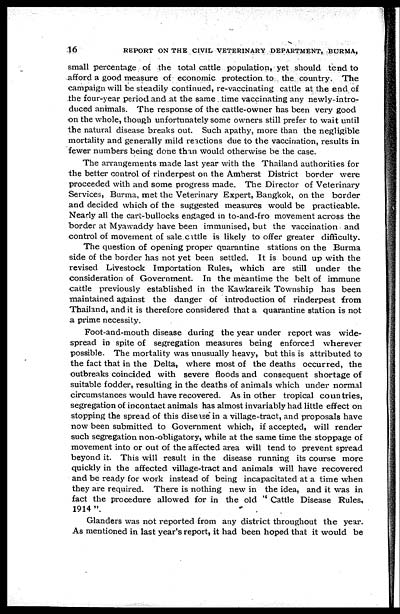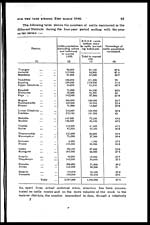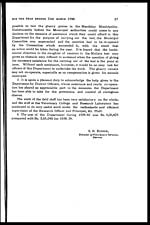Medicine - Veterinary > Civil Veterinary Departments > 1910-1941 - Annual report on the Civil Veterinary Department, Burma (including the Insein Veterinary School) > 1932-1941 > 1940
(457) Page 16
Download files
Individual page:
Thumbnail gallery: Grid view | List view

16 REPORT ON THE CIVIL VETERINARY DEPARTMENT, BURMA,
small percentage of the total cattle population, yet should tend to
afford a good measure of economic protection to the country. The
campaign will be steadily continued, re-vaccinating cattle at the end of
the four-year period and at the same time vaccinating any newly-intro-
duced animals. The response of the cattle-owner has been very good
on the whole, though unfortunately some owners still prefer to wait until
the natural disease breaks out. Such apathy, more than the negligible
mortality and generally mild reactions due to the vaccination, results in
fewer numbers being done than would otherwise be the case.
The arrangements made last year with the Thailand authorities for
the better control of rinderpest on the Amherst District border were
proceeded with and some progress made. The Director of Veterinary
Services, Burma, met the Veterinary Expert, Bangkok, on the border
and decided which of the suggested measures would be practicable.
Nearly all the cart-bullocks engaged in to-and-fro movement across the
border at Myawaddy have been immunised, but the vaccination and
control of movement of sale cattle is likely to offer greater difficulty.
The question of opening proper quarantine stations on the Burma
side of the border has not yet been settled. It is bound up with the
revised Livestock Importation Rules, which are still under the
consideration of Government. In the meantime the belt of immune
cattle previously established in the Kawkareik Township has been
maintained against the danger of introduction of rinderpest from
Thailand, and it is therefore considered that a quarantine station is not
a prime necessity.
Foot-and-mouth disease during the year under report was wide-
spread in spite of segregation measures being enforced wherever
possible. The mortality was unusually heavy, but this is attributed to
the fact that in the Delta, where most of the deaths occurred, the
outbreaks coincided with severe floods and consequent shortage of
suitable fodder, resulting in the deaths of animals which under normal
circumstances would have recovered. As in other tropical countries,
segregation of incontact animals has almost invariably had little effect on
stopping the spread of this disease in a village-tract, and proposals have
now been submitted to Government which, if accepted, will render
such segregation non-obligatory, while at the same time the stoppage of
movement into or out of the affected area will tend to prevent spread
beyond it. This will result in the disease running its course more
quickly in the affected village-tract and animals will have recovered
and be ready for work instead of being incapacitated at a time when
they are required. There is nothing new in the idea, and it was in
fact the procedure allowed for in the old " Cattle Disease Rules,
1914".
Glanders was not reported from any district throughout the year.
As mentioned in last year's report, it had been hoped that it would be
Set display mode to: Large image | Zoom image | Transcription
Images and transcriptions on this page, including medium image downloads, may be used under the Creative Commons Attribution 4.0 International Licence unless otherwise stated. ![]()
| Permanent URL | https://digital.nls.uk/75803784 |
|---|




